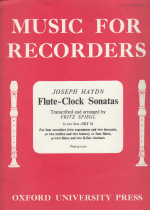Flute-Clock Sonatas Set Ii
Last updated: 19.12.19

| Composer: | J. Haydn | Suppliers: | |
| Editor: | Fritz Spiegel | Quartet | S/S/D/D |
| Publisher: | Oxford University Press | Publication: | OUP |
Like Wolfgang A. Mozart, Ludwig van Beethoven, and other composers of the time, Haydn composed and arranged a number of works for Flötenuhr. These instruments were mechanical organs with one or more ranks of flute quality stops and were therefore known as Flute Clocks. Although such things are now looked upon as mechanical toys they provided in their time the only mechanical means of reproducing music, and those that survive have left valuable evidence of contemporary performances. Both phrasing and articulation, for example, were amazingly clear, and although their performance was indeed "mechanical" refinements such as rallentandi or cadenzas were not unknown.
Ornaments were played almost exclusively on the beat, and the trills clear, measured, not too fast and beginning on the upper note. Repeated notes were invariably staccato. Only the treatment of appoggiaturas leaves us little the wiser; these varied, often in identical contexts, from long, full-value notes to short, crisp snaps.
The two Minuets in Set I may be played as Minuet and Trio, with the customary da capo. The opening march in Set II is an infantry march which exists also in another version for wind instruments (Hoboken viii: 6). The tune in the last movement of Set II also appears in the finale of a violin concerto by Viotti.
For the present edition the manuscripts in the Öffentliche Wissenschaftliche Bibliothek, (Berlin) and in the Gesellschaft der Musikfreunde (Vienna), as well as one of the surviving instruments, were consulted by kind permission. the title "Sonatas" appears in the Vienna manuscript.
My comments
Fascinating as the above is, this item has been languishing only briefly looked at in my library for almost twenty years, never played, unheard. I have never found the players. If I ever do, I will first try with two trebles and two tenors instead of two sopraninos and two descants (too squeaky!).

